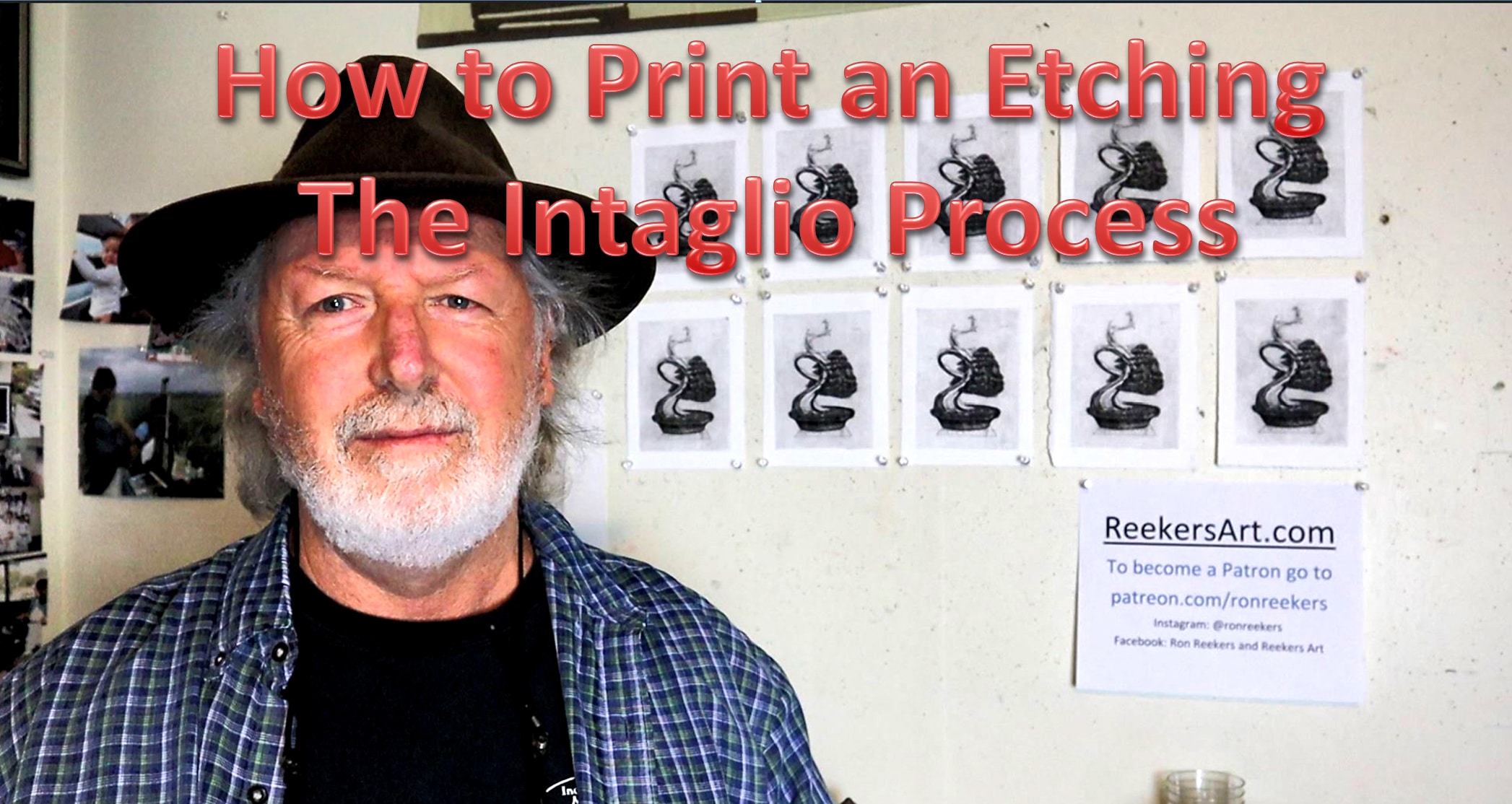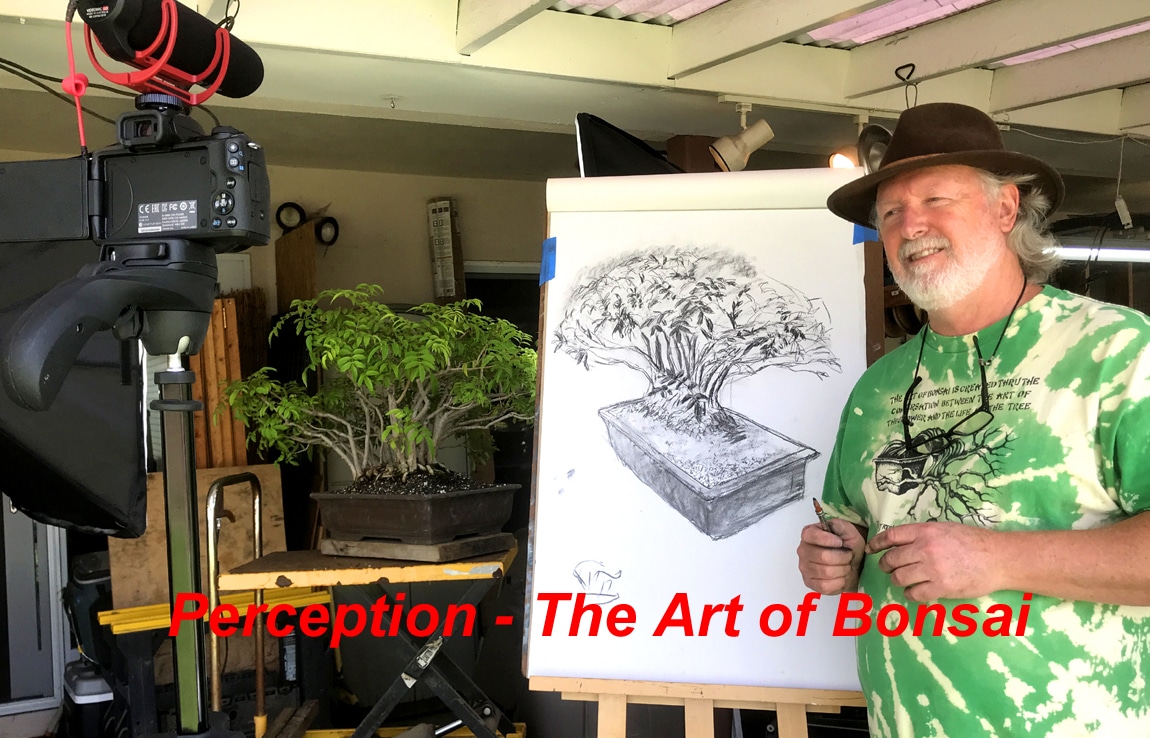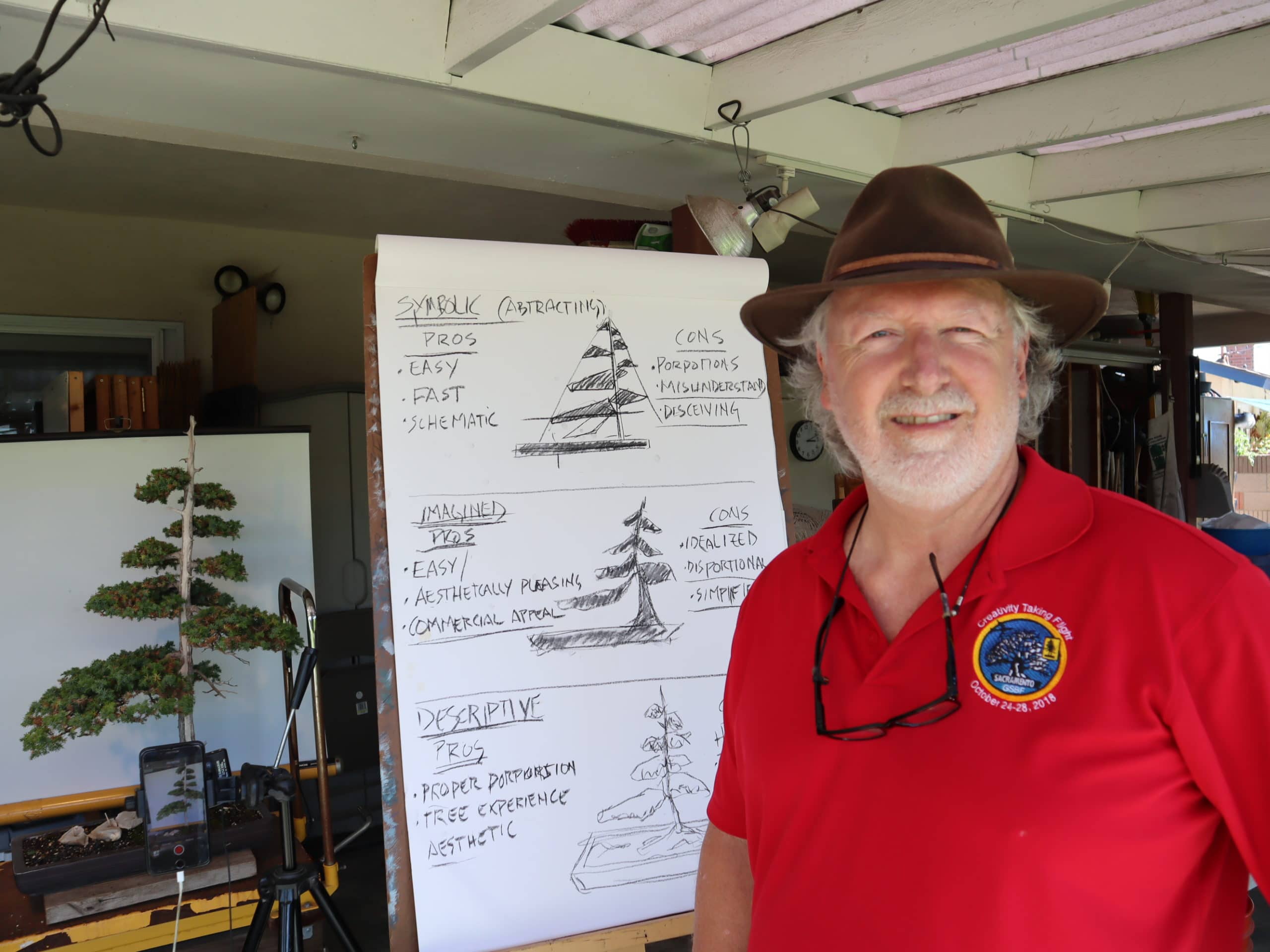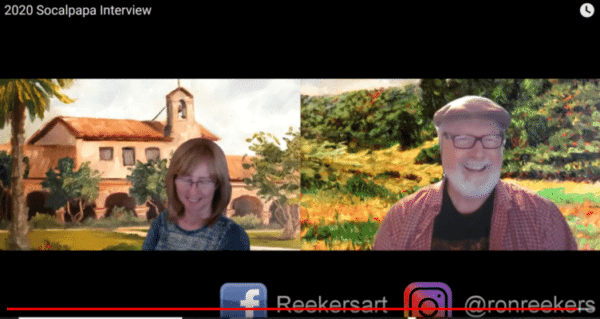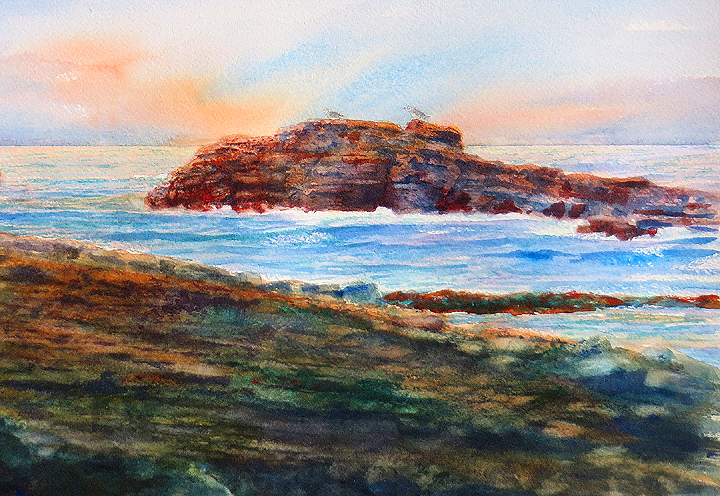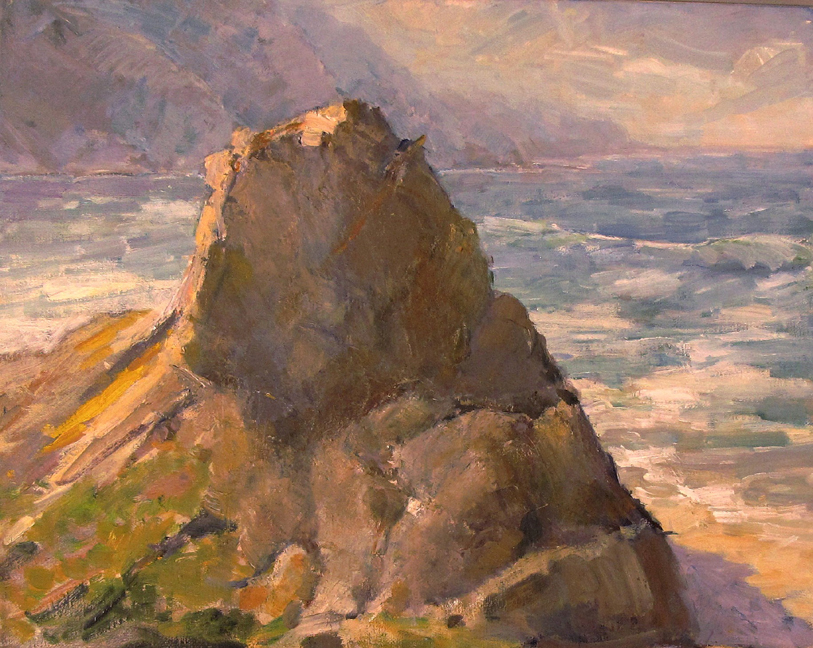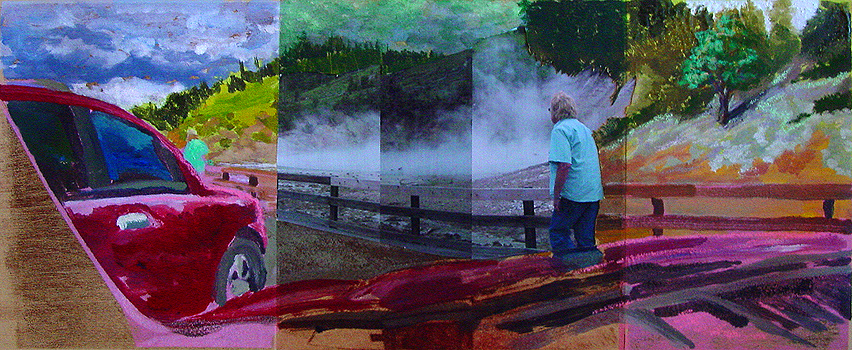We had six attendees this month that included a wide variety of media and styles.

Ron presented three beachscapes (about a quarter sheet size), based on some plein-air painting on the coast of Laguna Beach. Comments were about the rich color and brushwork were used to capture the rocky island and foreground structure. All of them were well composed and well painted, using horizontal bands for the beach, shore, island, distant sea and sky. Discussions concerned primarily the relative simplicity of the clouds and sky versus the rocks, and ways to add additional detail and structure to clouds without overcomplicating them. Good background glow worked very well in all of them.
 Donna first presented an excellent monoprint that she had made in an art class at OCC in 2004. It portrayed a semi-abstract view of a waterfall with scattered vegetation. There was a wide variety of marks, colors and textures that created all-over, multi-layered surfaces. We agreed that it was finished and not much more should be done. Her second piece was a large, mixed-media work portraying an all-over color field of stone shapes and surface markings, which included oil pastel. The rich, detailed shapes worked nicely up close, but lacked a spatial hierarchy of rhythm and movement. Several possibilities for improvement were discussed, including collage, geometric grid, open spaces, lean to detailed drawing such as in the works of Julie Mehretru, and reworking for a variation of pattern.
Donna first presented an excellent monoprint that she had made in an art class at OCC in 2004. It portrayed a semi-abstract view of a waterfall with scattered vegetation. There was a wide variety of marks, colors and textures that created all-over, multi-layered surfaces. We agreed that it was finished and not much more should be done. Her second piece was a large, mixed-media work portraying an all-over color field of stone shapes and surface markings, which included oil pastel. The rich, detailed shapes worked nicely up close, but lacked a spatial hierarchy of rhythm and movement. Several possibilities for improvement were discussed, including collage, geometric grid, open spaces, lean to detailed drawing such as in the works of Julie Mehretru, and reworking for a variation of pattern.
 Jared presented a group of three, small, color photographs in vertical format and horizontal sequence, with a small, transparent, plastic throw-away camera mounted at the end of the photos. This work was his first art project done recently in his photography class whose assignment was an artistic narrative of a location. The photos presented a parking lot on Beach Blvd where a sculpture exhibition was placed. The black asphalt lot was adjacent to a yellow stucco house, with what looked like white marble statues of a Greek goddess. The photos presented a distant to close-up sequence of one cropped-view statue, using the yellow house and black asphalt surface to good effect to frame the context of each view.
Jared presented a group of three, small, color photographs in vertical format and horizontal sequence, with a small, transparent, plastic throw-away camera mounted at the end of the photos. This work was his first art project done recently in his photography class whose assignment was an artistic narrative of a location. The photos presented a parking lot on Beach Blvd where a sculpture exhibition was placed. The black asphalt lot was adjacent to a yellow stucco house, with what looked like white marble statues of a Greek goddess. The photos presented a distant to close-up sequence of one cropped-view statue, using the yellow house and black asphalt surface to good effect to frame the context of each view.
Positive comments were that the photos and the zoom-in sequence provided a temporal dimension that worked well, that the black/yellow/white colors worked well together, and that the art-sale location was clear and yet mysterious as to the focus on one female statue. No title was given as a context. Another suggestion was made to move the multi-color photo to the front to begin the sequence and end the sequence with the close-ups of two views of the house. Another suggestion was to add another sheet with some text description or narration that adds both detail, drama and/or mystery.
 Thom presented two recent small works in his “Earth Tree” series, concerning large trees of the earth as they relate to the welfare of humanity and nature. The first work was in a new and experimental painting style for him. It used a bright red canvas ground with multiple, horizontal bands of color with broken edges between them to show the red ground. Positive comments were made about the richness of color and the semi-abstract character of the background with the broken red lines between them. However, the foliage of the tree top was not effective in suggesting a canopy with volume and sky light.
Thom presented two recent small works in his “Earth Tree” series, concerning large trees of the earth as they relate to the welfare of humanity and nature. The first work was in a new and experimental painting style for him. It used a bright red canvas ground with multiple, horizontal bands of color with broken edges between them to show the red ground. Positive comments were made about the richness of color and the semi-abstract character of the background with the broken red lines between them. However, the foliage of the tree top was not effective in suggesting a canopy with volume and sky light.
Thom’s second work was in his Cubist/Expressionist style in a square format. Critique comments were that the main tree was interesting, but that the gestural style side trees were too different for the composition to hold together. Also, the background brown color was too dark and did not integrate with the tree shape.
Andrew presented three, abstract, medium sized paintings in oil in vertical formats. The first two were reworked that have been previously seen and critiqued. Positive comments were that these present a unique style and meditative, painted in a confident style of subtle color fields, overlaid with patterns of brush marks of luminous color and in a variety of sizes and shapes. There are multiple layers of space suggested in a playful and intuitive manner. Andrew described these open compositions as analogous to his music.
 The third painting was more structured in shape and ground relationship that he described as figurative. The subtle contrasts were painted using only four colors – black, white, red ochre and lead white. One influence in his work is Paul Klee. Comments were made that the frame detracted from the work, that some areas were too subtle so as to be almost empty and in a dull greyed tone. This was debated as to the nature of how to portray silence, quietness and the degree of subtlety that communicates with an art audience that has an experience with Western art tradition. Our art tradition permits the painter full freedom and license to follow his own direction. However, quiet paintings may take time to appreciate.
The third painting was more structured in shape and ground relationship that he described as figurative. The subtle contrasts were painted using only four colors – black, white, red ochre and lead white. One influence in his work is Paul Klee. Comments were made that the frame detracted from the work, that some areas were too subtle so as to be almost empty and in a dull greyed tone. This was debated as to the nature of how to portray silence, quietness and the degree of subtlety that communicates with an art audience that has an experience with Western art tradition. Our art tradition permits the painter full freedom and license to follow his own direction. However, quiet paintings may take time to appreciate.
Hosted by Ron Reekers, notes by Thom Wright.

